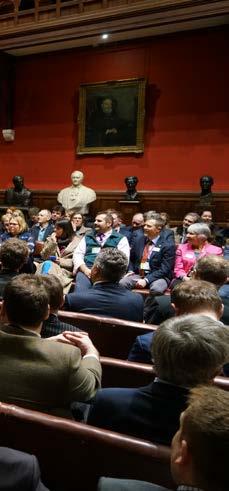
4 minute read
Practice OFC Debate
This house believes that humans will not be needed on farms in a generation
The 2023 Oxford Farming Conference debate in the historic Oxford Union debating chamber was an opportunity for agricultural engineering to argue for autonomous agriculture. A pair of eminently experienced and able IAgrE members made the case.
Advertisement
First up for the motion was Professor Simon Pearson from the Lincoln Institute of Agricultural Technology (LIAT). The proposition’s contention was that this prophesy is already happening. With official figures showing that within 100 years (one lengthy lifetime), in 1921 just under 1m people were working on English farms, by 2021 this was 301,000 of which only 67,000 were regular workers and 41,000 were casuals.
In 2019, according to the ONS 63,000 EU citizens worked seasonally on UK farms, now, with Covid, Brexit, the war in Ukraine and the age/urbanisation demographics that number is much reduced. In 2021, farms could not and did not secure the labour they needed.
The UK labour crisis is well documented, so the driver of technology in farming is not to replace labour in farming systems, it is to find machines and technology to fill this labour gap.
Going back to the premise of the debate’s motion, it’s not just a question that workers ‘are not needed’ on farms, they are simply not available.
To sum up, Prof Pearson said: ‘ Technology is on the march, British robots in Ocado pack and distribute food on a massive scale, they have a market capitalisation £5.6 billion larger than Sainsbury’s, and as we speak robots on Mars are sampling the soils!’
“Guys, you are wrong”
David Rose from Farmeco in
Ground truth
NASA’s chief engineer for the Saturn V rocket programme said: “one good test is worth a thousand expert opinions.” Mr Franklin asked delegates if they would stand with naysaying opinions on the opposite bench or with Professor Pearson and himself, the testers, with hard earned first-hand knowledge of farm robotics and automation? Voting for this motion would save future generations the drudgery and danger of farm work whilst making Net Zero sustainable businesses a reality.
Nottinghamshire rose to his feet in opposition to the motion. He contended that: “there should be more people involved in farming.” He felt strongly that tech has not solved all the problems it has set out to do.
“Technology is removing our ability to think creatively. We need to think and look at partnerships on the land.” He stated that partnerships used technology to reduce chemicals and fertiliser use.
Farming will need more highly skilled people to do the job better and harness the technology.
Mr Rose urged the audience to vote against the motion and herald in a new agricultural era of people and the countryside.

The few feeding the many
Kit Franklin, lead investigator of the Hands Free Farm project at Harper Adams University was straight back up in defence of the motion as its second.
“If the technology is ready and raring, what is this need for automation?” he opened. “Let us remember what agriculture is? The ability of the few to feed the many through the adoption of ever emerging science and technology. In current times that means a mere 1% of the UK population producing food for the 99%, down from 5% 100 years ago and if you stretch back to the Roman era 70-80% were working the land.”
Silent fields
OFC director Ben Taylor Davies closed the opposition with 60 seconds of silence to remind the audience of what farming sounds like without people. He made the correlation between science and technology adaption on farm and the reduction of people on the land.
Ben said that the argument in favour of the motion was “trivial in comparison to the suicide statistics in farming.”
When we look at agricultural engineering there have been many successes, “but a farm which runs around people is a farm which cares,” he closed by saying.
The motion was convincingly defeated by 234 for the noes and 76 for the ayes.
Precision provides perfect pinot
Using precision tools to layout vineyards could help managers run them with increased use of robotics, both reducing manual labour requirements and improving yields.
So says Ian Beecher-Jones, who detailed the ideas he is trying at Jojo’s Vineyard, near Henley on Thames to a recent IAgrE lunchtime lecture.
As well as being of interest to the growing number of UK vineyard owners, he suggested the ideas have potential to be deployed more widely across the row crop sector. Mr Beecher-Jones – who works as a consultant on yield mapping software systems with CNHi and is a former Director General of BAGMA –runs the vineyard with his wife Tess on their smallholding.
Four years ago they planted 9,000 vines of seven different varieties on five acres And they have plans to start developing their own winery at the end of the year.
Mechanising vineyards is the way forward, he says, pointing out that it took a two-man crew just six hours to plant 70% of the vineyard mechanically, using RTK to ensure accuracy. Supply issues meant the rest of the vines arrived late, and the contractor had moved on.
So, the remaining 30% of the vineyard was planted manually, an operation that took two men three days.
But when the contractors had finished their work, he was shocked that they could not provide a map showing precisely where every vine was located:
“It seemed strange that we are going to have a product in the ground for 30 years and – with all the technology available – nothing was being recorded”.
Exact position
He wanted to know the exact position of every vine and every row, and then add other important information such as the locations of soil sampling points.




